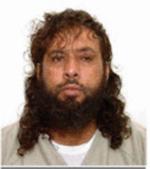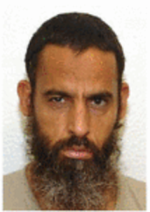| Information |  | |
Derechos | Equipo Nizkor
| ||
| Information |  | |
Derechos | Equipo Nizkor
| ||
04Apr16
US transfers 2 Guantanamo detainees to the Republic of Senegal
The Department of Defense and State Department announced today that two Libyans have been transferred from Guantanamo to the Republic of Senegal in West Africa.
Omar Khalifa Mohammed Abu Bakr Mahjour Umar and Salem Abdul Salem Ghereby allegedly belonged to the al Qaeda-linked Libyan Islamic Fighting Group (LIFG), worked with senior al Qaeda leaders and had advanced explosives training in Afghanistan prior to their detention in Cuba.
President Obama's Guantanamo Review Task Force, which reviewed the detainees' cases between Jan. 2009 and Jan. 2010, deemed Umar "too dangerous" to free. But a Periodic Review Board subsequently approved Umar's transfer last year.
Joint Task Force Guantanamo (JTF-GTMO), which oversees the detention facility, assessed both of the men to be "high" risks who are "likely to pose a threat to the US, its interests, and allies."
Omar Khalifa Mohammed Abu Bakr Mahjour Umar (Internment Serial Number 695)

Omar Khalifa Mohammed
Abu Bakr Mahjour UmarJTF-GTMO was especially concerned about Umar. In an Aug. 22, 2008 threat assessment, which was later leaked online, JTF-GTMO recommended that the Defense Department continue to hold him.
JTF-GTMO's analysts also issued a warning: "If released without rehabilitation, close supervision, and means to successfully reintegrate into his society as a law abiding citizen, it is assessed detainee [Umar] would immediately seek out prior associates and reengage in hostilities and extremist support activities."
US officials found that Umar was a high-level member of the LIFG's military committee and worked with a Who's Who list of al Qaeda leaders and operatives.
Umar was allegedly a "long-time associate" of Osama bin Laden, worked for one of the al Qaeda founder's companies, and flew on one of bin Laden's planes from Sudan to Afghanistan.
Umar also reportedly had "affiliations" with: Ayman al Zawahiri (the current head of al Qaeda), Saif al Adl (a senior al Qaeda official wanted for his role in the August 1998 US Embassy bombings), Abd al Rahim al Nashiri (a current Guantanamo detainee and suspected ringleader of the USS Cole bombing in October 2000), Abu Musab al Zarqawi (who founded al Qaeda in Iraq before his demise in June 2006), Abu Laith al Libi (an al Qaeda leader who was killed in 2008), Hamza al Qaiti (who served as an al Qaeda commander in Afghanistan and Chechnya), as well as others.
Still other al Qaeda leaders, some of whom were held in the CIA's controversial detention and interrogation program, are cited as sources of intelligence on Umar throughout the leaked JTF-GTMO threat assessment. One of them is Ahmed Ghailani, who was tried and convicted for his role in the 1998 US Embassy bombings. Ghailani identified Umar as a trainer at al Qaeda's Al Farouq training camp and told authorities that Umar "taught anti-aircraft systems and basic explosives."
According to the intelligence included in the leaked threat assessment, Umar moved seamlessly between LIFG and al Qaeda facilities in Sudan and Afghanistan during the 1990s. He allegedly worked as an "explosives and weapons trainer at LIFG and al Qaeda training camps in Afghanistan." JTF-GTMO found that he also helped rebuild al Qaeda's camps after airstrikes were launched in retaliation for the attacks on US Embassies in Kenya and Tanzania in August 1998.
On Mar. 28, 2002, Umar was captured during raids on two suspected al Qaeda safe houses in Faisalabad, Pakistan. The counterterrorism operations targeted Abu Zubaydah's "Martyrs Brigade," which planned to launch improvised explosive device (IED) attacks against US and Coalition forces in Afghanistan. JTF-GTMO's analysts assessed that Umar was a "a participant in [Zubaydah's] cell," or "Martyrs Brigade." Zubaydah, a senior al Qaeda facilitator, is still detained at Guantanamo.
President Obama's Guantanamo Review Task Force, which filed its final report in January 2010, shared JTF-GTMO's security concerns about Umar.
The task force determined that Umar should be held under the 2001 Authorization for Use of Military Force (AUMF) because he was one of 48 detainees "determined to be too dangerous to transfer but not feasible for prosecution."
However, a Periodic Review Board (PRB) determined in August 2015 that Umar's detention was "no longer necessary to protect against a continuing significant threat to the security of the United States."
The PRB acknowledged Umar's "past terrorist-related activities and connections," but found that the "risk" he "presents" could be mitigated by his "significantly compromised health condition," his "record of compliance" within Guantanamo, and his "recent engagement with his family illustrating his intent to move forward in a positive manner."
Even so, the PRB couldn't rule out the possibility that Umar would return to the jihad.
The August 2015 decision reads: "The PRB also recommends appropriate security assurances as determined by the Guantanamo Detainee Transfer Working Group, with special attention to those that would mitigate the threat the detainee [Umar] may pose with respect to propaganda, recruitment, and training of others."
According to data compiled by The Long War Journal, Umar is the fifth detainee since September of last year to be transferred after being deemed "too dangerous to transfer" by Obama's task force. A sixth detainee was also transferred despite being recommended for prosecution by the task force. In all six cases, President Obama's interagency body concluded that the detainees should be held. But they were granted transfers from Guantanamo by the PRB system, which is increasingly willing to transfer higher risk detainees.
Salem Abdul Salem Ghereby (ISN 189)

Salem Abdul Salem GherebyUnlike Umar, Salem Abdul Salem Ghereby was approved for transfer by President Obama's task force more than six years ago. This doesn't mean the task force believed he was an innocent who could be freed without any security precautions. The task force recommended Ghereby for transfer "to a country outside the United States that will implement appropriate security measures."
Unlike Umar, Salem Abdul Salem Ghereby was approved for transfer by President Obama's task force more than six years ago. This doesn't mean the task force believed he was an innocent who could be freed without any security precautions. The task force recommended Ghereby for transfer "to a country outside the United States that will implement appropriate security measures."
JTF-GTMO concluded that Ghereby was a "former explosives trainer and a veteran jihad fighter" in the LIFG. He was also allegedly "associated" with senior al Qaeda members, including Abdul Hadi al Iraqi (Bin Laden's primary paramilitary commander prior to 9/11) and Ibn Shaykh al Libi. Bin Laden named al Libi as the leader of al Qaeda's forces during the Battle of Tora Bora in late 2001. (Al Iraqi is held at Guantanamo. Al Libi died in a Libyan prison in 2009.)
JTF-GTMO's analysts found that Ghereby "attended multiple training camps" and "received explosives training" from a "senior al Qaeda explosives expert" known as Abu Khabab al Masri. According to the leaked JTF-GTMO threat assessment for Ghereby, Masri's diary describes the explosives accident that cost Ghereby his fingers and vision in one eye.
JTF-GTMO's analysts also assessed that Ghereby participated in the Battle of Tora Bora and fled the mountain range with Ibn Shaykh al Libi and other jihadists.
LIFG and al Qaeda in North Africa
The LIFG, which Umar and Ghereby served, found new life in North Africa during the uprising against Muammar Gaddafi in 2011 and afterwards. In fact, Osama bin Laden and his top lieutenant believed in early 2011 that "an active Jihadist Islamic renaissance" was "underway." Al Qaeda was encouraged by the fact that many LIFG members, some of whom also served al Qaeda, had been freed from jail. One of them was another ex-Guantanamo detainee who was a member of both al Qaeda and the LIFG: Sufian Ben Qumu. Today, Ben Qumu is best known for his putative role in the Sept. 11, 2012 attacks in Benghazi.
According to the terms of their transfer, it is likely that the Republic of Senegal is responsible for ensuring, at least in the short-term, that Umar and Ghereby do not rejoin their LIFG brethren elsewhere in Africa. Of course, it is possible that one or both of them will choose a different path.
[Source: By Thomas Joscelyn, The Long War Journal, NJ, 04Apr16]
 | This document has been published on 02May16 by the Equipo Nizkor and Derechos Human Rights. In accordance with Title 17 U.S.C. Section 107, this material is distributed without profit to those who have expressed a prior interest in receiving the included information for research and educational purposes. |